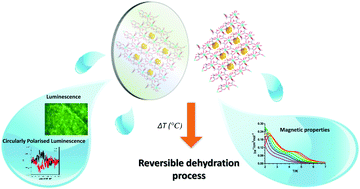Influence of thermally induced structural transformations on the magnetic and luminescence properties of tartrate-based chiral lanthanide organic-frameworks†
Abstract
This work reports on the synthesis and characterization of five enantiomeric pairs of isostructural 3D metal–organic frameworks (MOFs) with the general formula {[Ln2(μ4-tar)2(μ-tar)(H2O)2]·xH2O}n [where Ln(III) = Tb (Tb-L and Tb-D), Dy (Dy-L and Dy-D), Ho (Ho-L and Ho-D), Er (Er-L and Er-D) and Tm (Tm-L and Tm-D); tar = tartrate (D- or L-) and x = 3 or 4 depending on the counterpart], which possess interesting luminescence and magnetic properties. These MOFs undergo progressive and reversible dehydration processes upon controlled heating yielding three crystalline phases (Ln-L′, Ln-L′′ and Ln-L′′′). Alternating current magnetic measurements on Tb, Dy and Er-based compounds exhibit field induced single-molecule magnet behavior dominated by QTM, which is partially suppressed when diluted on a Y-based matrix. Tartrate ligands show poor room temperature sensitization of Tb and Dy centers that is enhanced at low temperature (10 K), even enabling weak Tm-based emission. More interestingly, the dehydration modulates both magnetic and photoluminescence properties on the basis of both the distortions occurring in the coordination shells and a decrease of water molecules acting as quenchers, respectively, endowing these materials with potential humidity sensing capacity. Remarkably, the Tb-based MOF shows circularly polarized luminescence (CPL), being one of the examples of this very scarce family of CPL emitters reported so far.



 Please wait while we load your content...
Please wait while we load your content...